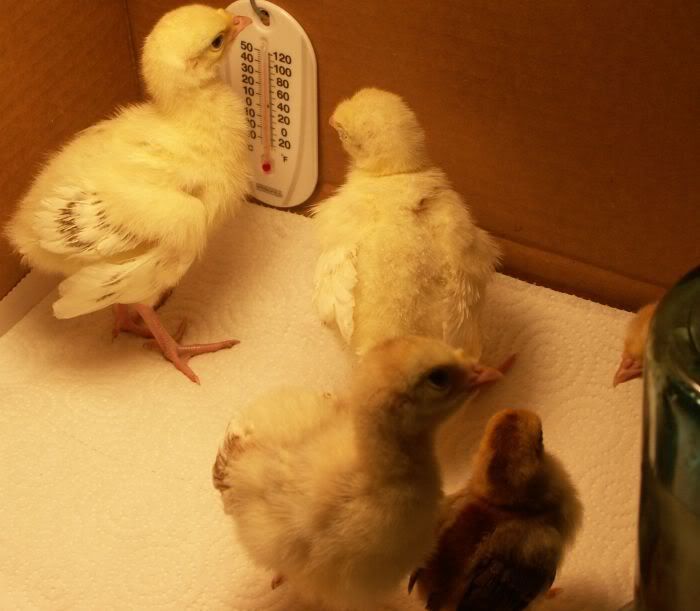
royal palms strutting stuff
The chickens and guineas were so successful, we decided to try turkeys. Discussions with a moderator on the BHM forums, Deberosa, made the birds sound quite appealing. We eat a lot of chicken, and turkey is another favorite. We’ve never asked ourselves how many turkeys we could eat in a year. Once again, Storey’s had the only current publication on turkeys. The book was a bit of a disappointment, being concerned almost exclusively with production breeds. After learning that the heritage breeds come in a variety of sizes, we settled on royal palm for the first attempt.

royal palm poults with banty friend in brooder
When the poults were a little over a month we moved them outside. We bought them from a Mennonite fellow that hatches them. He puts a bantam chick in with the poults to keep them in line. The banty figures out eating and drinking, providing an example for the poults, and goads the poults into staying active. I had read where it was necessary to keep turkeys and chickens separated to prevent black-head disease in the turkeys. The Mennonite we bought the poults from, as with Deberosa, raises the turkeys and chickens together. Our intention is to slaughter two turkeys and keep a breeding pair for future hatches. The turkeys will be turned loose to graze with the chickens when they are large enough. The Mennonite fellow also recommended chicken feed as adequate for turkeys. You may not raise record breaking birds, but that isn’t our goal. This does much to simplify feeding and quarters. The poults grew quickly and we trained them with scratch so they will return to their pens when called. I was letting the turkeys roost in the trees and on top of the fence, with the guineas, but we lost a tom. Best we can figure is a raccoon. Whatever it was, it climbed the fence and made off with the turkey. We followed the trail, and it looks like the tom got loose twice - there were two spots with a lot of feathers, but we never did find blood or carcass.
A friend gave us a white broad breasted turkey, giving me a chance to compare the two breeds. The royal palms are smaller birds - like large chickens. The broad breasted is a commercial breed. It has been bread to grow a freakishly large breast. These turkeys have to be reproduced by artificial insemination - more intimate terms than I'd like to be on with a turkey. The breast actually interferes with the tom delivering the mail. The poor creature seemed to have to make an effort to mocve around and showed signs of suffering from foot problems. When we got her she had signs of breast blisters, a common malady with this breed.
Just last weekend we slaughtered our one suplus royal palm and the broad breasted. The bb dressed out like a turkey you'd expect to find at the grocery store and came in at 16 lbs. ready for the freezer. The rp dressed out at 9.5 lbs. and looked like a large chicken. Ample meat but not a freakishly large breast. Turkeys are much easier than chickens to clean - there's a lot more room inside the chest cavity for organ removal, etc.
I can see why these birds are so popular. In 24 weeks we were able to raise 9.5 lbs. of meat without a lot of effort. That was on chicken feed. Using the higher protien turkey feed (no doubt at additional expense) these birds may have been ready at 12 weeks, the beginning of the window for slaughter. I haven't done the math yet, but there may be cost savings in there also.
Regards,
Pat
